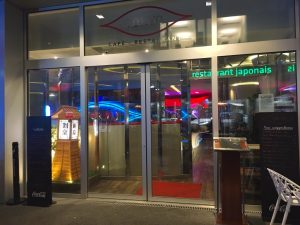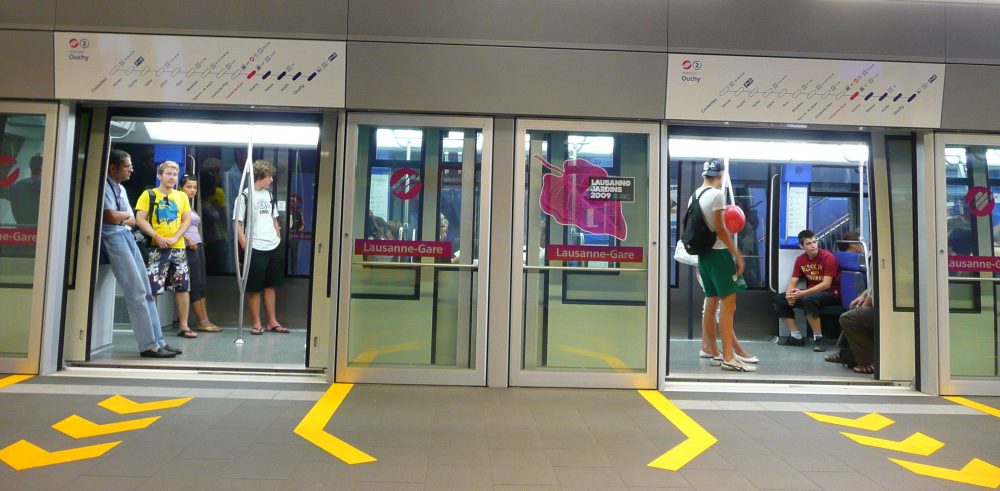The Hospitality Industry in Lausanne: Attraction of Ethnicity and Commercial Multilingualism
Samantha Crupi, Chloé Vicat-Cole
Abstract
This paper investigates the role of East Asian commercial activities (with the use of Japanese and Chinese), predominantly restaurants, in Lausanne, namely in the area between Valentin district and Lausanne-Flon, including Place Saint-François. The presence of bilingual or multilingual signs brings along the use of a strategic multilingualism: by advertising traditional dishes and products, mostly in the language connected to the restaurant’s national origins, the message that is conveyed is that of authenticity. Our research tries to understand how the native languages in these signs are used to attract locals, tourists, people speaking the same tongue, or with a receptive knowledge of it and how they are employed in the creation of a foreign cultural space for the customer.
1. Introduction
As people arrive from other countries, they do not only carry their cultural baggage, but they bring also their different languages and expressions. Big urban cities tend to attract immigrants more than provincial areas (Zachary, 2006). Because of the appeal of cities, different cultural networks are created, where some communities establish themselves, distance from other cultures, or blend with the diversity of the cultures. An example of this phenomenon is Lausanne, with a percentage of 43.1% foreigners, presenting a wide variety of languages, including the ones investigated in this research. In Switzerland, during 2016, the foreigners were at 2 million people, with a 10.6% of Asian origins, that includes a 0.27% of Japanese people and 0.85% from China.
Within the European territory there are large differences in population size amongst EU nation-states (Extra & Yagmur, 2010). European nations are distinguished by the language proper to the territory. Even though there is the presence of other languages than the official ones in Switzerland, these migrant languages are obscured by this “match between nation-state references and official state language references” (Extra & Yagmur, 2001, p.1173). The languages spoken by minor groups in the cities of Switzerland may reveal themselves with their presence in writings and signs.
The presence of East Asian culture and languages in Swiss town is nonetheless strong and used to commercialize shops and restaurants. The theme approached by our research on a city characterized by multilingualism, the town of Lausanne, is the use of the Japanese and Chinese language in commercialization of products and restaurants and as a way to communicate with as many people as possible. More precisely, our research will investigate the exploitation of culturally themed East Asian restaurants as a way to attract tourists and commercialize a certain ethnicity.
Our research will firstly present a theoretical framework about the use of semiotic material in cities and how ethnicity can be exploited in the hospitality industry. Then the ares taken into account for the research will be briefly contextualized. The methodology for the collect of the material analyzed will be explained. Afterwards, the results of the analysis of the places taken into account for the study will be unfolded, along with a discussion of the results. The paper will conclude with a brief summary of what the research helped us determine about our hypothesis.
The following examples are Asian restaurants situated in Lausanne, starting from the Eglise Saint-Laurent, and following the streets scatter from the latter. The routes taken are Rue Pré-du-Marché, Rue Pichard, and Rue-Grand-Saint-Jean. Our research includes also the area of Lausanne-Flon.
2. Theoretical Framework
In cities and towns there is an abundance of ‘semiotic’ material, which is related to semiotics, namely the study of signs and symbols (Semiotics, n.d.). Signs, posters and other commercial advertisement material covers all of the environment of the city around us, composing the linguistic landscape. As underlined by Ben-Rafael, Shohamy and Barni, as cited by Mooney & Evans (2015), the ‘linguistic objects…mark the public space’ (p. 87). The continuous presence of signs and adverts have an influence on the individual, who can be attracted particularly by certain of them. This attraction comes from how the sign are structured and designed. The color of the image they figure can be a source of allure to people. Moreover, the language used represents a crucial factor for what concerns the information that the sign is giving and to whom it is addressed to. In adopting multilingual signs, the producer is choosing an audience and a certain way to approach and attract the potential addressee.
Given that signs are often conceived with the intention to attract a potential costumer, East Asian restaurants in Lausanne use ethnically based themes and their native language as a way to create a cultural separated environment from the city, where the client will picture her/himself in another place and decorations that evoke a different culture. Ebster and Guist (2005), in their research in the authenticity of the ethnic theming in restaurants, determined that theming is used to provide the customers with a “unique experience” that will differentiate “their business from the competition” (p. 42). The uniqueness offered by these kinds of restaurant will attract tourists and locals, who would like to experience something outside the ordinary. Gilmore and Pine, as cited by Ebster and Guist (2004), noted that that marketers have been increasingly using theming as “a marketing tool to provide their costumers with a unique experience, and to differentiate their business from the competition” (p. 42), demonstrating that theming is important and prevalent in the hospitality industry.
The language is used as a way to communicate to the costumer, therefore the choice of language is “never random” (Pahta, 2007, p. 284). Holmes, in her study, as commented by Pahta (2007), examines how “advertising and other market-driven discourses use languages and exploit linguistic difference in order to sell products and services” (p. 285). The discrepancy created between the native language of the client and the language used in restaurants (in the signs and menus) creates a space of discovery for the client, who will the possibility of experiencing a different culture from his own, or at least to imagine himself in another place. The appearance of an unfamiliar culture is communicated through the use of the foreign language in the restaurant.
This research demonstrates that the choice of language used in a commercial sign is an important factor that is exploited to sell a certain image of a place, in our case a restaurant. Whereas the use of clichés as the foundation of a cultural themed restaurants will attract tourists in search for “alien delights” (p. 70), as stated by Zelinsky, and cited by George (2009).
3. Contextualization
Lausanne, situated in the French-speaking part of Switzerland, being the capital of Canton Vaud, represents a centre of development, where economy, urbanism and public transport are in a continuous modification. According to the Office d’appui économique et statistique (2017), Lausanne has now 144’000 inhabitants, of which approximately 40’000 are foreigners, making it the fourth most populated city in Switzerland.
The area taken into account for this research includes the streets passing near the Saint-Laurent Eglise. Because of the central position of the latter, it has the possibility of witnessing the life of the city. The portrait figured over the entrance of the church of Martin Luther King attracts the pedestrians, inviting them to take the holy place into consideration in their daily routine. The Saint-Laurent Eglise constitutes a pole from which many streets with different shops and restaurants branch off.
Among the areas of Lausanne taken into consideration for this research, there is Flon. The latter was once used as a warehouse for cargo, but has now become Lausanne’s most innovative and modern neighborhood. Flon hosts shopping centres, offices, parking lots, bars and night clubs. The area preserved the original style of the 1900 with its rectangular shaped buildings squared compounds. It starts from Place d’Europe and is enclosed between Avenue Jules Gonin, Rue des Terreaux and Pont Chauderon. The two areas taken into account for the research are based on the popularity they have among tourists and locals too, they represent the core of marketing in Losanne.
4. Methodology
The data collected for this study is formed from eleven signs from eight different East Asian commercial activities located in downtown Lausanne, collected personally by ourselves while roaming around the city center. More precisely, we focused on the area from Valentin district to Flon, including Place Saint-François. Twelve photos were taken starting from Rue Pré-du-Marché, then continuing on Rue Pichard and Rue Grand-Saint-Jean, until Place Saint-François. Finally we ended up in the Quartier du Flon.
The subjects chosen are signs placed outside activities, in which bilingual (or multilingual) written messages are presented. In particular, we selected East Asian related commerces, mostly restaurants, which display different cultural networks that spread around the city by mixing multiple languages, usually French (the official language spoken in Lausanne) along with Japanese or Chinese (or another Asian language, both in Roman and Chinese transcriptions). The choice of prioritizing Asian signs occurred mainly because of the several Asian advertisements composing the linguistic landscape of downtown Lausanne. The analysis has been developed firstly on the choice of the language in written signs, its support (or medium), the activity domain, the type of sign. Another element of the analysis concerned whether the sign were examples of a bottom-up or top-down relationship. We distinguished a bottom-up with a top-down relationship on the basis of the source of the written sign: in a bottom-up relationship the message is not official, it is produced by individual or small groups; in a top-down relationship the message is released by the government, local councils or the owner of a building or site, the composition presents official languages or/and a strategic multilingualism. The use of strategic multilingualism indicates the choices of a certain language as a strategy to attract the largest number of costumers possible. From the analysis, we expected to face a variety of Asian 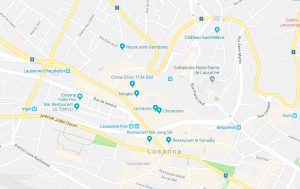 multilingualism in restaurants and shop’s signs, aiming to attract citizens who are willing to experience different cultural traditions. Furthermore, we were surprised to encounter so many commercials related to the South-East Asia, meaning that this kind of business is very popular nowadays. Contrary to many cities in the world, downtown Lausanne does not have a specific area that is called “Chinatown”, where all Asian commercial activities and traditions are gathered together. Instead, it is possible to find them scattered in the whole city center.
multilingualism in restaurants and shop’s signs, aiming to attract citizens who are willing to experience different cultural traditions. Furthermore, we were surprised to encounter so many commercials related to the South-East Asia, meaning that this kind of business is very popular nowadays. Contrary to many cities in the world, downtown Lausanne does not have a specific area that is called “Chinatown”, where all Asian commercial activities and traditions are gathered together. Instead, it is possible to find them scattered in the whole city center.
5. Results
Written instances in different languages are linguistic landscape strategic tools that actively appeal to whoever would ever visit, work or live in a given city. In every example we provided, there is a mixture between characters from the Roman transcriptions and the Japanese/Chinese writing systems, occasionally English borrowings are included within the signs. The first image displays the front entrance of an Asian restaurant, called “Le Dynasty”, located in Place Saint-François. The sign is characterized by a combination of French as the official language, English as lingua franca and Chinese as second language. Here, visitors and citizens do not need to understand any of the languages proposed, since it is clear what this restaurant offers: people are familiar to the Chinese transcriptions even though they do not understand the language, therefore they easily link the restaurant to Asian cooking. French is therefore used for a communicative purpose, it gives more details on the cuisine offered. Similarly, English sentences “Fast Food” (as well as the example of Picture 3) and “Take Away” are utilized worldwide to indicate a fast cooking that can be delivered directly home, or that can be eaten to go. In this particular case, English also adds informations about the services, that include take away and fast food. Nowadays, this type of food is especially popular in cities because of the life people endure. Life is moving faster in big cities and time is precious for workers, therefore the quickest cookings are prioritized. For this reason, the choice of a certain language fall for a specific one rather than others. This commercial sign is taking advantage of these circumstances, thus it puts forward visual symbols to attract costumers who are looking for these particular services. The information (Picture 1) are written in French, the official language, although it was already clear what type of restaurant is presented. This sign was meant to adapt to what cities represent. In other words, the owner of the restaurant benefits from the popularity of fast and take away Asian cooking in order to attract as many costumers as possible. For these reasons, this type of sign corresponds to an example of top-down relationship, since the owner is implementing a strategic multilingualism to increase the appeal of his own activity.
Picture 1. Sign of Le Dynasty Restaurant
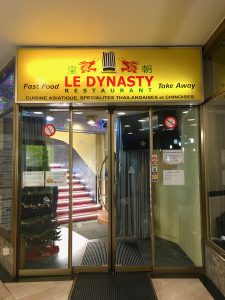
Picture 2. Sign of Majong Restaurant
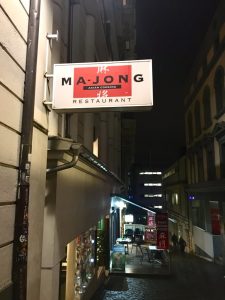
Picture 3. Window text of Majong Restaurant
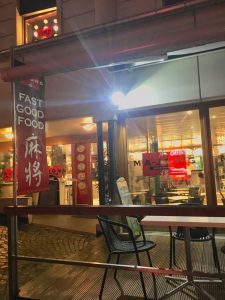
Another common strategy of Asian restaurants is based on the authenticity of the products that are offered. It is interesting to notice how the entrance of the Asian restaurant “Ningbo”, placed in Rue Pichard, is highlighted by the red board with a Chinese inscription on it (Picture 4). The pedestrians immediately recognize what kind of service this restaurant is offering, they are instantly projected into a different culture, namely this monolithic commodification of the Chinese culture constructed for the market.
Picture 4. Sing of Ningbo Restaurant
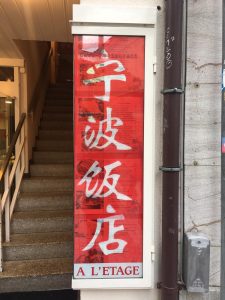
Picture 5. Close-up of the Menu of Ningbo Restaurants
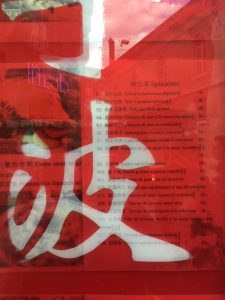 Subsequently, in case of interest, people need to come closer to check the menu. The menu, next to the French description of the particular meal, provides of the Chinese description as well (Picture 5). French is also employed as translations within the advertisement poster outside the building (Picture 6). As a result the client will feel even more distant from the diner, allowing him/her to feel the restaurant as a true Asian experience, pulling him/her away from the traditional European culture of Lausanne. According to Zukin’s research (1998), culture is a way to define public space and to justify its takeover on the basis of commercial benefits. The city center is aimed to attract costumers and it causes consumption to become an integral part of the culture. The owner of the commercial activities are delivering these messages, influencing potential costumers into visiting their business, therefore this relationship can be classified as top-down.
Subsequently, in case of interest, people need to come closer to check the menu. The menu, next to the French description of the particular meal, provides of the Chinese description as well (Picture 5). French is also employed as translations within the advertisement poster outside the building (Picture 6). As a result the client will feel even more distant from the diner, allowing him/her to feel the restaurant as a true Asian experience, pulling him/her away from the traditional European culture of Lausanne. According to Zukin’s research (1998), culture is a way to define public space and to justify its takeover on the basis of commercial benefits. The city center is aimed to attract costumers and it causes consumption to become an integral part of the culture. The owner of the commercial activities are delivering these messages, influencing potential costumers into visiting their business, therefore this relationship can be classified as top-down.
Picture 6. Sign outside of Ningbo Restaurant
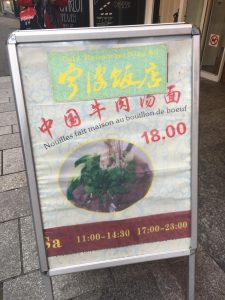
Picture 7. Sign of Uchitomi Shop
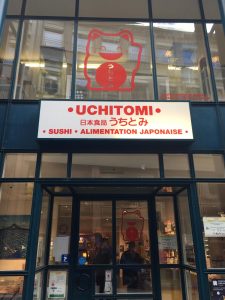
Down Rue Grand-Saint-Jean, there is the Japanese food shop “UCHITOMI”. The name of the shop is first written in the Latin alphabet, beneath it the Japanese characters are also used (Picture 7). Nearby the entrance of the shop the sign that presents the daily menu is exposed. The offer is presented with a mixture of Japanese and French words: Bento is a Japanese term indicating a particular tray, a typical object in the Japanese cuisine, then it follows “du jour” that guarantee s the major attention of passers-by (Picture 8), since French is the official language spoken in Lausanne. Thanks to this mixture, tourists and citizens do not need to be part of a determinate culture, or to learn a foreign language neither, to understand the message that stands behind commercial signs and they are encouraged to come in to taste an authentic Asian experience, even though in reality is just a construction and therefore, an illusion.
Picture 8. Sign outside of Uchitomi Shop
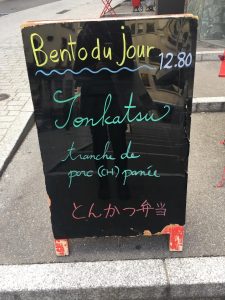
6. Discussion
The signs used by the restaurant owners in Lausanne, show how the Asian culture is used as a way to capture the passers-by’s interest in another culture.
The examples proposed in the pictures figure an adaptability to native people of Switzerland and tourism, by following a concept built as a strategy for market, meaning that the advertisement utilized correspond to the same concept of cliché-based ethnicity (Ebster and Guist, 2004). Chinese and Japanese inscriptions recall East-Asian countries, and in this particular case the cuisine attached to: the potential customers is witnessing an experience of a constructed authentic Asian experience because of the translations provided. The multiple languages suggested in the same sign, extend the public able to recognize what type of service a company is offering. Language becomes consequently a strategy to draw potentials costumers, as Leeman and Modan (2009) state: “urban planners and city leaders have sought to draw suburbanites back into the city by offering them shopping, dining and cultural experiences not available in the suburbs” (p. 339). In their study, they analyze how Chinatown in Washington DC appeal to the whole city: it increases the consumption in big cities and it proposes new experiences that people from the countryside cannot encounter. Likewise, downtown Lausanne is mixing different cultures and traditions to extend its cultural baggage and to put forward its citizens and tourists to extra cultural experiences.
7. Conclusion
The city center is where the different languages spoken in certain areas of the town enter in contact with each other, thus it is a place where multilingualism is not only present but also needed: multilingualism provides a way of communication but is mostly exploited by the hospitality industry to make people understand certain signs and attract clients. By emphasizing a different language from the one of the speaker, the restaurants and shops want to create an exotic place, where the client will detach from his everyday life and will experience something out of the ordinary.
Our hypothesis was that to attract costumers, as shown by the signs analyzed, East Asian restaurants and shops would exploit and emphasize their foreign language, enough to make costumers feel interested in a place out of the ordinary. By placing the costumer in another cultural setting, the aim is to provoke a sentiment of estrangement, allowing him/her to feel like being in another town, and feeling, as states above, “alien delights” (George, 2009, p. 70).
The client is looking for an adventure that will exit his routine, and this feeling can be created by the examples given in the Results section. The hypothesis formulated before our research has been confirmed by the large choice of Asian restaurants that presents numerous writings in their native language mixed with French and English.
Our research confirmed what we already hypothesized about the use of Asian signs. It would be interesting, for future researches, to conduct this study in a city where there are agglomerations of foreign restaurants and shops and see how they affect the native people of the city. Such a research could be run in Little Italy or in Chinatown in New York city.
References
Esbter, C., & Guist, I. (2008). The Role of Authenticity in Ethnic Theme Restaurants. Journal of Foodservice Business Research, 7, 41–52.
Extra, G., & Yagmur, K. (2011). Urban Multilingualism in Europe: Mapping Linguistic Diversity in Multicultural Cities. Journal of Pragmatics, 43, 1173–1184.
George, T. R. (2009). Journal of Restaurant & Foodservice Marketing. Dining Chinese, 4(2), 67–86.
Leeman, J., & Modan, G. (2009). Commodified Language in Chinatown: A Contextualized Approach to Linguistic Landscape. Journal of Sociolinguistics, 13(3), 332–362.
Mooney, A. & Evans, B. (2015). Language, Society and Power. Oxon: Routledge.
Pahta, P. (2007). Advertising as Multilingual Communication.Language in Society 36(2), 284–289.
Zachary, G. (2006). Immigrants as urban saviors: When Immigrants Revive a City and When They Don’t- Lessons from the United States, 1.
Zukin, S. (1998). Urban Lifestyles: Diversity and Standardization in Spaces of Consumption. Urban Studies, 825–839.
Websites
MySwitzerland website. Available on: https://www.myswitzerland.com/fr-ch/quartier-du-flon-lausanne.html. Accessed on 26.12.2018
Official website of the city of Lausanne. Available on: http://www.lausanne.ch/lausanne-en-bref/lausanne-un-portrait.html. Accessed on 26.12.2018
Official statistics of Lausanne, on the official website of Lausanne. Available on: https://www.lausanne.ch/officiel/statistique/portrait-statistique.html. Accessed on 20.12.2018
Official statistics of Swiss tourism 2017, on the official site of the Federation of Switzerland. Available on: https://www.stv-fst.ch/sites/default/files/2018-07/stiz_en.pdf. Accessed on 26.12.2018
Official website of the Saint-Laurent Eglise. Available on: http://saintlaurenteglise.eerv.ch/qui-2/. Accessed on 28.12.2018
Appendix
- Pictures of the remaining signs not discussed in detail in this paper:
1.1 Name of a Chinese Restaurant located in Rue Grand-Saint-Jean.
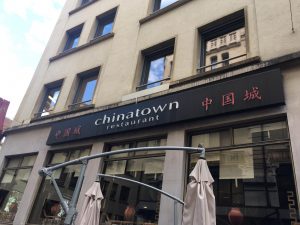
1.2 Sign of a Chinese clinic offering traditional curative medicine located in Rue Haldimand.
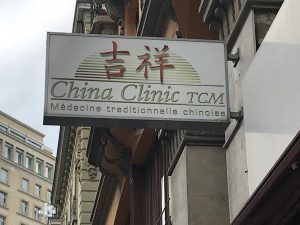
1.3 Japanese Restaurant with typical Japanese objects at the entrance (Japanese lantern).
